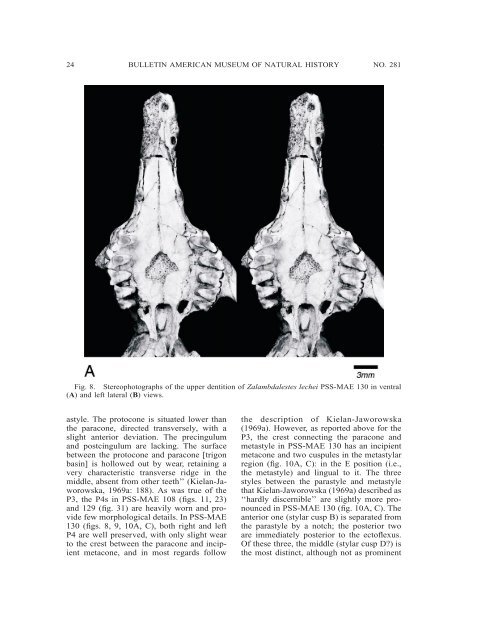zalambdalestes - American Museum of Natural History
zalambdalestes - American Museum of Natural History
zalambdalestes - American Museum of Natural History
You also want an ePaper? Increase the reach of your titles
YUMPU automatically turns print PDFs into web optimized ePapers that Google loves.
24 BULLETIN AMERICAN MUSEUM OF NATURAL HISTORY NO. 281<br />
Fig. 8. Stereophotographs <strong>of</strong> the upper dentition <strong>of</strong> Zalambdalestes lechei PSS-MAE 130 in ventral<br />
(A) and left lateral (B) views.<br />
astyle. The protocone is situated lower than<br />
the paracone, directed transversely, with a<br />
slight anterior deviation. The precingulum<br />
and postcingulum are lacking. The surface<br />
between the protocone and paracone [trigon<br />
basin] is hollowed out by wear, retaining a<br />
very characteristic transverse ridge in the<br />
middle, absent from other teeth’’ (Kielan-Jaworowska,<br />
1969a: 188). As was true <strong>of</strong> the<br />
P3, the P4s in PSS-MAE 108 (figs. 11, 23)<br />
and 129 (fig. 31) are heavily worn and provide<br />
few morphological details. In PSS-MAE<br />
130 (figs. 8, 9, 10A, C), both right and left<br />
P4 are well preserved, with only slight wear<br />
to the crest between the paracone and incipient<br />
metacone, and in most regards follow<br />
the description <strong>of</strong> Kielan-Jaworowska<br />
(1969a). However, as reported above for the<br />
P3, the crest connecting the paracone and<br />
metastyle in PSS-MAE 130 has an incipient<br />
metacone and two cuspules in the metastylar<br />
region (fig. 10A, C): in the E position (i.e.,<br />
the metastyle) and lingual to it. The three<br />
styles between the parastyle and metastyle<br />
that Kielan-Jaworowska (1969a) described as<br />
‘‘hardly discernible’’ are slightly more pronounced<br />
in PSS-MAE 130 (fig. 10A, C). The<br />
anterior one (stylar cusp B) is separated from<br />
the parastyle by a notch; the posterior two<br />
are immediately posterior to the ect<strong>of</strong>lexus.<br />
Of these three, the middle (stylar cusp D?) is<br />
the most distinct, although not as prominent
















